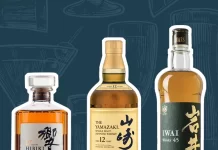If you’re a newcomer to the world of whisky, Japanese whisky can be a great place to start. Known for its smooth and mellow flavor, Japanese whisky has been gaining popularity among whisky enthusiasts and novices alike in recent years. In this beginner’s guide, we’ll cover everything you need to know about Japanese whisky, from its history to its production methods and popular brands.
History of Japanese Whisky
Japanese whisky has a relatively short history compared to other types of whisky, dating back to the early 20th century. The first Japanese whisky distillery was established by Masataka Taketsuru, who had studied the art of whisky-making in Scotland. Taketsuru returned to Japan in 1920 and established the Yamazaki distillery in 1923. Other distilleries soon followed, including Nikka Whisky’s Yoichi distillery in 1934.
Japanese whisky production was put on hold during World War II, but it resumed after the war ended. Japanese whisky gained international recognition in the 2000s, when the Yamazaki 12 Year Old won the Best Whisky in the World award at the International Spirits Challenge.
Production Methods
Japanese whisky production methods are heavily influenced by traditional Scottish whisky-making techniques. Japanese distilleries typically use a combination of malted and unmalted barley, as well as other grains such as wheat and rye, to create their whiskies. The water used in Japanese whisky production is also of utmost importance, as it can greatly affect the final flavor of the whisky.
Japanese distilleries typically use pot stills to distill their whisky, which can give the whisky a smoother and more delicate flavor. The whisky is then aged in wooden barrels, typically made of oak. Japanese whisky distilleries often use a variety of barrel types for aging, including ex-bourbon, sherry, and wine barrels, which can give their whiskies unique flavors and aromas.
Flavors of Japanese Whisky
Japanese whisky is known for its smooth and mellow flavor, with notes of fruit, oak, and spices. Japanese whiskies are often described as being less peaty and smoky than Scotch whiskies, making them a great choice for beginners who are still getting used to the taste of whisky.
Some of the most popular Japanese whisky brands include Suntory, Nikka, and Hibiki. Suntory’s Yamazaki and Hakushu whiskies are known for their fruity and floral notes, while Nikka’s Yoichi and Miyagikyo whiskies are known for their rich and complex flavors. Hibiki whiskies are a blend of Suntory’s Yamazaki, Hakushu, and Chita whiskies, and are known for their balance and harmony of flavors.
How to Enjoy Japanese Whisky
There’s no one “right” way to enjoy Japanese whisky, as everyone’s tastes and preferences are different. However, there are a few general tips that can help you get the most out of your Japanese whisky experience:
Start with a high-quality whisky: It’s worth investing in a high-quality Japanese whisky, as the flavor and aroma will be more complex and enjoyable.
Serve the whisky at the right temperature: Most Japanese whiskies are best served at room temperature or slightly chilled, as this can bring out the flavors and aromas.
Use a clean glass: Make sure the glass you’re using is clean and free from any residue, as this can affect the taste of the whisky.
Sip slowly and savor the flavor: Take small sips of the whisky and let it linger in your mouth for a few moments.






